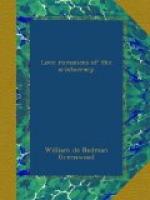This scathing criticism refers to pedigrees which profess to be based on existing records; what shall we say, then, of those family trees which have their ambitious roots in the dark centuries which no ray of genealogical light can possibly pierce? Take, for instance, that amazing pedigree of the Lyte family of Lytes Cary, at the head of which is “Leitus (one of the five captains of Beotia that went to Troye),” whose ancestors came to England first with Brute, “the most noble founder of the Britons.” (It is only fair to say that the present representative of this really ancient family, Sir H. Maxwell-Lyte, an expert genealogist, turns his back resolutely on the Beotian captain, and even on Brute himself, and generally lops his family tree in a merciless but most salutary fashion.)
The College of Arms, among many amazing pedigrees, treasures one of a family “whose present representative is sixty-seventh in descent in an unbroken male line from Belinus the Great (Beli Mawr), King of Britain,” which actually exhibits the arms of Beli, who, poor man, died long centuries before heraldry was even cradled.
Of families who derive descent from Charlemagne the name is legion; but even such elongated pedigrees are quite contemptible in their brevity compared with others which have at their head no other progenitor than Adam, the father of us all. At Mostyn Hall, we learn, there is a vellum roll, twenty-one feet long, of pedigrees, some of which “are traced back to ‘Adam, Son of God,’ without any conscious sense of the incongruous”; and these records, we must remember, are in the hand of “a man thoroughly trustworthy as to the matters of his own time.” There is in the College of Arms a similar family tree which commences boldly with Adam and the Garden of Eden; and an authority on Welsh pedigrees declares,
“A Welshman whose family was in any position in the sixteenth century can, as a rule, without much trouble find a pedigree thence to Adam; an Englishman who is unable to do the same has a natural tendency to regard all Welsh pedigrees with distrust, not to say contempt.”
Mr Horace Round gives some startling examples of flagrant dishonesty, where forgery is only one of the implements used. Take, for example, that shameful story of the “Shipway frauds,” which is thus referred to by a clergyman of the parish.
“In the fall of 1896, by an elaborate system of impudent frauds, an unscrupulous attempt was made to claim these monuments for one who was an entire stranger to the parish. An agent from London was employed in a search for a pedigree. He, by fraudulent means, concocted a very plausible story. Genealogies were manufactured, tombs were desecrated, registers were falsified, wills were forged—in a word, various outrages were committed, with many sacred things in this parish and elsewhere. These two figures, as part of the pedigree, were deposited in a niche in the chantry; on either side were huge brass tablets on which were engraven various untruthful and unfounded statements.”
In another case Hughenden Church was desecrated to gratify the vanity of a family of Wellesbourne, anxious to trace their descent from the Montforts.




